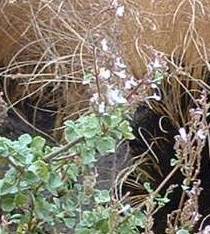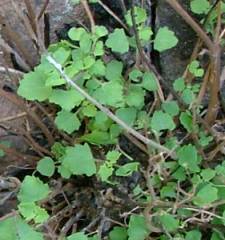Aeollanthus parvifolius
Aeollanthus parvifolius Benth.
Family: Lamiaceae
Common names: rock sage (Eng.), klipsalie (Afr.)
Introduction
Aeollanthus parvifolius is a drought-tolerant, succulent, autumn-flowering plant suitable for dry bushveld and grassland gardens. Its succulent nature makes is a worthwhile subject for self-sustaining gardens.

Description
Description
Multi-stemmed, aromatic, long-lived, fast-growing succulent shrublet up to 0.8 m tall. Leaves spreading in opposite pairs, egg-shaped to rounded, 15-55 x 8-25 mm, on short leaf stalks; margin with 2 to 3 pairs of shallow teeth. Branches rounded and more or less a pencil thickness. Flowers appear during late summer and autumn; are characteristically two-lipped, tubular and up to 12 mm long, white to light pink and carried on lax panicles. The fruit has a persistent calyx at the base of the flower which breaks loose when ripe, releasing the small seeds ( usually 4 nutlets per calyx).

Conservation Status
Status
Aeollanthus parvifolius is a common species and thus not protected. In its habitat, when burnt by fire, plants will simply re-sprout.
Distribution and habitat
Distribution description
Aeollanthus parvifolius is essentially a montane and cliff-dwelling species. It has a wide distribution in areas receiving mainly summer rainfall from the northern Eastern Cape to the Mpumalanga Drakensberg and surrounding area, including Swaziland and a single record from Mozambique . Its habitat consists of grassland, savanna and Afro-temperate vegetation. It often grows in rock crevices, varying from a south- to north-facing aspect. It is well suited to cultivation on the highveld and bushveld but also thrives well in the Western Cape . Rainfall varies from 400-1 500 mm. It is resistant to light frost and should re-sprout after a cold spell. It thrives in rockeries, containers and borders. It is very drought tolerant and an ideal water-wise plant.

Derivation of name and historical aspects
History
The name Aeollanthus is derived from the Greek Aiolos , the god of the wind; anthos means flower. The specific epithet parvifolius is derived from the Latin parvi, small and folius , foliage, referring to its relatively small leaves. Aeollanthus parvifolius is one of six South African species.
Aeollanthus parvifolius was first collected by the German plant collector Johann Drège (1794-1881) in the Eastern Cape , between the Msikaba and Mzimvubu Rivers during 1836. It was described by the Bentham in 1848.
The genus Aeollanthus, family Lamiaceae, is African, with about 45 species. Many other members of Aeollanthus make worthwhile garden subjects including A. buchnerianus, A. rehmanii and A. suaveolens.
Ecology
Ecology
The succulent nature of the leaves and stems makes the plant drought tolerant. Although it is often well protected from fires on the bare rocks and rock faces, it simply re- sprouts from the base after a fire. The plant grows actively during summer, flowering towards the end of the season. It is pollinated by insects. Seed (small nutlets) is retained in the calyx, which enlarges after fruiting and becomes closed at the throat. A circumscissile weak region at the base of the calyx develops, ensuring a clean break when it is dry, releasing the seeds.

Uses
Use
Aeollanthus parvifolius is cultivated and used mainly in rockeries.
Growing Aeollanthus parvifolius
Grow
The species is easily propagated from cuttings throughout the year but in colder climates it should preferably be done in spring or summer. Soft tip cuttings root rapidly in sand (1 to 3 weeks). Herbaceous, older material can also be used with great effect, but rooting is slower (about 2 to 4 weeks). The plant roots rapidly in clean sand, or mixtures of peat and sand; it grows very easily and thrives as a pot plant. Plants can be fed with a balanced organic fertilizer. Maintain a neat plant by pruning it hard after flowering in late autumn. It is best used in highveld and bushveld gardens on sunny rockeries in areas where frost is not severe. It also grows well in the Western Cape but should preferably be watered during the summer. Companion plants include Crassula, Cotyledon, Delosperma and Haworthia . It is fairly pest free.
References
- Ryding, O. 1986. The genus Aeollanthus s. lat. (Labiatae). Symbolae Botanicae Upsalienses XXVI: 1: 130, 131.
Credits
Ernst van Jaarsveld
Kirstenbosch National Botanical Garden
February 2005
Plant Attributes:
Plant Type: Perennial, Shrub, Succulent
SA Distribution: Eastern Cape, KwaZulu-Natal, Limpopo, Mpumalanga
Soil type: Sandy, Loam
Flowering season: Autumn
PH: Acid, Neutral
Flower colour: White, Pink, Mauve/Lilac
Aspect: Full Sun
Gardening skill: Easy
Special Features:
Horticultural zones









Rate this article
Article well written and informative
Rate this plant
Is this an interesting plant?
Login to add your Comment
Back to topNot registered yet? Click here to register.